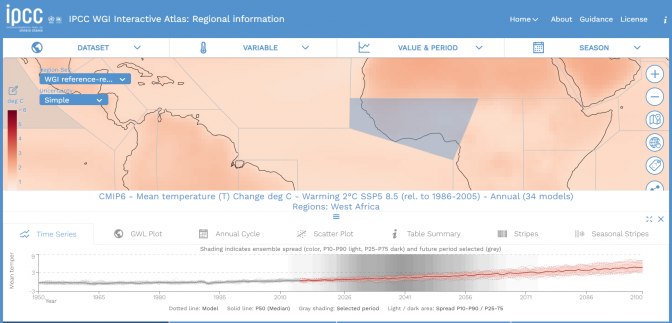Home / Guinean forests / Threats / Climate change
Climate change
The current situation
According to the latest report of the Intergovernmental Panel on Climate Change (IPCC), scientists are observing changes in the climate in all world regions. Many of the observed changes are unprecedented in thousands of years, and some of those already underway – such as continued sea level rise – are irreversible over hundreds or thousands of years.
However, strong and sustained reductions in greenhouse gas emissions (carbon dioxide (CO2), in particular) would limit climate change. In this case, global temperatures could be stabilised in 20-30
IPCC The Intergovernmental Panel on Climate Change (IPCC) is an intergovernmental body open to all member countries of the United Nations (UN). It currently comprises 195 states and is part of the World Meteorological Organisation and the United Nations Environment Programme. It was established in 1988 to provide comprehensive assessments of the state of scientific, technical and socio-economic knowledge on climate change, its causes, potential impacts and coping strategies.
For more information:
IPCC: https://www.ipcc.ch/about/
IPBES: The Intergovernmental Science-Policy Platform on Biodiversity and Ecosystem Services (IPBES) is the intergovernmental body that assesses the state of biodiversity and the ecosystem services this provides to society, in response to requests from policymakers. https://ipbes.net/
The IPCC Working Group I report ‘Climate Change 2021: The Scientific Basis’ Faster warming The report provides new estimates of the chances of passing the 1.5°C global warming threshold in the coming decades, and finds that unless immediate, rapid and large-scale reductions in greenhouse gas emissions are made, limiting warming to close to 1.5°C or even 2°C will be out of reach.
Every region of the world is facing increasing changes.
The report predicts that over the next few decades, climate change will increase in all regions. Climate change is causing multiple changes in different regions, all of which will increase with warming. These include:
- More intense precipitation and associated flooding in high latitudes;
- More intense droughts in many subtropical regions;
- Continued sea-level rise in coastal areas;
- Decreased seasonal snow cover, melting of glaciers and ice caps, disappearance of Arctic sea ice in summer;
- Warming, acidification and reduced oxygen levels in the oceans.
Human influence on past and future climate
Human activities emit large quantities of greenhouse gases. It is clear that carbon dioxide (CO2) is the main driver of climate change, although other greenhouse gases and air pollutants also affect the climate.
The report also shows that human actions can still determine future climate change.
Stabilising the climate will require strong, rapid and sustained reductions in greenhouse gas emissions, and the achievement of net zero CO2 emissions.
For more information:
New interactive IPCC Atlas presents information for all regions of the world, including West Africa: https://interactive-atlas.ipcc.ch/
Potential impacts of climate change on forests
On growing vegetation
Climate change has been observed in West Africa in recent decades. Regional climate projections show an increase in temperature in the region, but uncertainties remain regarding potential changes in rainfall.
It is likely that climate change will lead to increased carbon storage and vegetation productivity in Guinean forests. These results indicate that Guinean forests could become an even more valuable resource for carbon storage in the future, thus contributing to reducing the impacts of global climate change. However, the increase in future land use for human activities (shifting and industrial agriculture, logging and mining, etc.) is expected to significantly reduce this potential.
On biodiversity
Many West African animal species have been identified as vulnerable to climate change, based on their specific biological and ecological characteristics and ranges.
A large proportion of amphibians, birds, freshwater fish, mammals and reptiles are expected to move to less climatically suitable areas before the end of the 21st century.
Species range shifts are expected to lead to both losses and gains in species relative to the current species richness of Guinean forests.
Species that are both globally threatened and vulnerable to climate change should be considered as high priority for conservation action.
For these species, specific management options may include the identification of areas with a suitable persistent climate within their current distribution or the expansion (extension and connectivity) of the existing protected area network.
On migratory movements
Another possible impact of climate change is changes in rainfall in the Sahelian or sub-Sahelian zone north of the Guinean forests. This could lead to more frequent or longer periods of famine, which would cause large-scale human migration to forested areas further south, increasing the risk of deforestation.
The mangrove: a natural barrier against rising sea levels Mangrove forests are crucial ecosystems in the context of climate change, as they protect against storms, sea level rise and land erosion. They also capture carbon from the atmosphere, provide refuge for endangered species and offer livelihoods for coastal communities.
Conserving existing mangroves and restoring large tracts of degraded or removed mangroves will go some way to addressing global warming.


